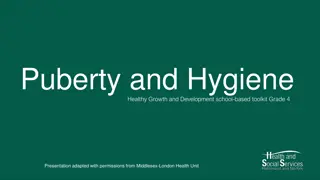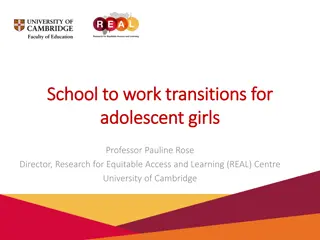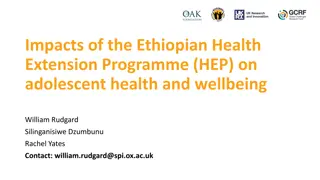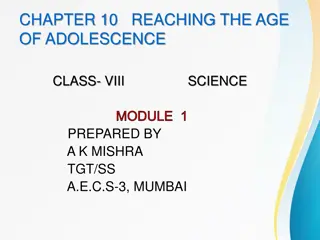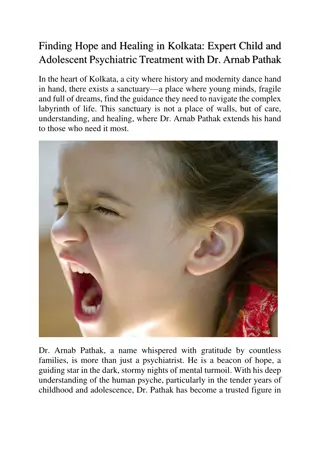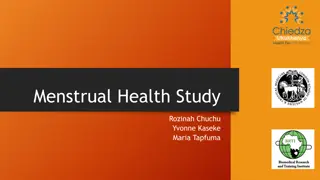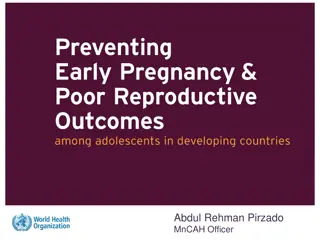Puberty and Menstrual Health in Adolescent Girls
Puberty is a crucial phase marked by physical changes in a child's body, leading to sexual maturity. Learn about the signs of puberty, menstrual cycle, ovulation, and common concerns faced by adolescent girls. Explore topics like premenstrual syndrome, contraception, and pelvic infections. Discover the development of secondary sex characteristics and anatomical abnormalities that may affect girls during puberty. Gain insights into supporting adolescent girls through this transformative period.
Download Presentation

Please find below an Image/Link to download the presentation.
The content on the website is provided AS IS for your information and personal use only. It may not be sold, licensed, or shared on other websites without obtaining consent from the author.If you encounter any issues during the download, it is possible that the publisher has removed the file from their server.
You are allowed to download the files provided on this website for personal or commercial use, subject to the condition that they are used lawfully. All files are the property of their respective owners.
The content on the website is provided AS IS for your information and personal use only. It may not be sold, licensed, or shared on other websites without obtaining consent from the author.
E N D
Presentation Transcript
CORE PROBLEM 7 THE PROBLEM 14-YEAR OLD
CASE A father brings his 14 year old daughter to the clinic. She is missing school because of regular tummy pains .
CORE TOPICS Puberty Premenstrual syndrome Contraception Pelvic infection
PUBERTY Puberty is the process of physical changes through which a child's body matures into an adult body capable of sexual reproduction initiated by hormonal signals that stimulate Libido function, and transformation of the brain, Physical growth bones, Muscle skin, hair breasts, Reproductive organs. begin at ages 10 11 complete puberty at ages 15 17
DEVELOPMENT SECONDARY SEX CHARACTERISTICS Female secondary sex characteristics include: Enlargement of breasts and erection of nipples. Growth of body hair, most prominently underarm and pubic hair Widening of hips lower waist to hip ratio than adult males Elbows that hypertextend 5 8 more than male adults. Upper arms approximately 2 cm longer, on average, for a given height. Labia minora, the inner lips of the vulva, may grow more prominent and undergo changes in colour with the increased stimulation related to higher levels of oestrogen.
MENSTRUAL CYCLE Average 28 days cycle Ovulation in 14thday Normal cycle proliferative and secretory menstrual phases follicular and luteal ovarian phases
WHAT ANATOMICAL ABNORMALITIES MAY THIS GIRL HAVE? Revision Could it be normal ? Medical History Menarche Cyclic colic pain ..
WHAT ANATOMICAL ABNORMALITIES MAY THIS GIRL HAVE?
PREMENSTRUAL SYNDROME Most women of reproductive age have one or more emotional or physical symptom in the premenstrual phase of the menstrual cycle DSM IV axons: (1) the presence of at least five luteal-phase symptoms (panel), at least one of which must be a mood symptom (ie, depressed mood, anxiety or tension, affect lability, or persistent anger and irritability); (2) two cycles of daily charting to confirm the timing of symptoms (3) evidence of functional impairment. Finally, symptoms must not be the exacerbation of another psychiatric condition.
SYMPTOMS Depressed mood or dysphoria Anxiety or tension Affect lability Irritability Decreased interest in usual activities Concentration difficulties Marked lack of energy Marked change in appetite, overeating, or food cravings Hypersomnia or insomnia Feeling overwhelmed Other physical symptoms eg, breast tenderness, bloating Symptoms markedly interfere with work, school, social activities, or relationships
TREATMENT OPTIONS FOR PMS Medical history Depression dysthymic disorder anxiety disorders Hypothyroidism sexual abuse post-traumatic stress disorder Serotonin reuptake inhibitors (SRIs) Hormonal interventions GnRH agonist Vitamin B6
PEARL INDEX The Pearl Index, also called the Pearl rate, is the most common technique used in clinical trials for reporting the effectiveness of a birth control and tampon selection
PEARL INDEX User dependence Side effects
HORMONAL VS NON-HORMONAL CONTRACEPTIVES
EMERGENCY CONTRACEPTION ECPs containing Ulipristal acetate Emergency contraceptive pills prevent pregnancy by preventing or delaying ovulation and they do not induce an abortion. ECPs containing Levonorgestrel combined oral contraceptive pills (Yuzpe method) copper-bearing intrauterine devices
CONTRAINDICATIONS TO THE COC PILL Thrombophlebitis or thromboembolic disorders Presence or history of venous thrombosis or arterial thrombosis History of migraine with focal neurological symptoms hyperhomocysteinaemia and antiphospholipid antibodies Valvular heart disease with complications Severe hypertension Diabetes mellitus with vascular involvement. Presence or history of liver tumours (benign or malignant). Known or suspected malignant conditions of the genital organs or the breasts, Endometrial hyperplasia. Known or suspected pregnancy. Hypersensitivity
PELVIC INFECTION Symptoms and signs of PID none Fever cervical motion tenderness lower abdominal pain Vaginal discharge painful intercourse uterine tenderness adnexal tenderness irregular menstruation Other complications include endometritis, salpingitis, tubo-ovarian abscess, pelvic peritonitis, periappendicitis, and perihepatitis.
CAUSES OF PID AND TREATMENT Chlamydia trachomatis and Neisseria gonorrhoeae are usually the main cause of PID. Data suggest that PID is often polymicrobial.[14]Isolated anaerobes and facultative microorganisms have been obtained from the upper genital tract. N. gonorrhoeae has been isolated from fallopian tubes, facultative and anaerobic organisms were recovered from endometrial tissues.[17][18] ascend from the vagina to the pelvic cavity The disturbance of the naturally occurring vaginal microbiota associated with bacterial vaginosis increases the risk of PID. Rarely cases of PID have developed in people who have stated they have never had sex.[19]
CONTACT TRACING contact tracing is the process of identification of persons who may have come into contact with an infected person ("contacts") and subsequent collection of further information about these contacts
SHORT AND LONG-TERM COMPLICATIONS OF PID chronic pelvic pain Infertility ectopic pregnancy (the leading cause of pregnancy-related deaths in adult females), complications of pregnancy infection oof the peritoneum causing inflammation and the formation of scar tissue on the external surface of the liver (Fitz-Hugh Curtis syndrome).[16]






